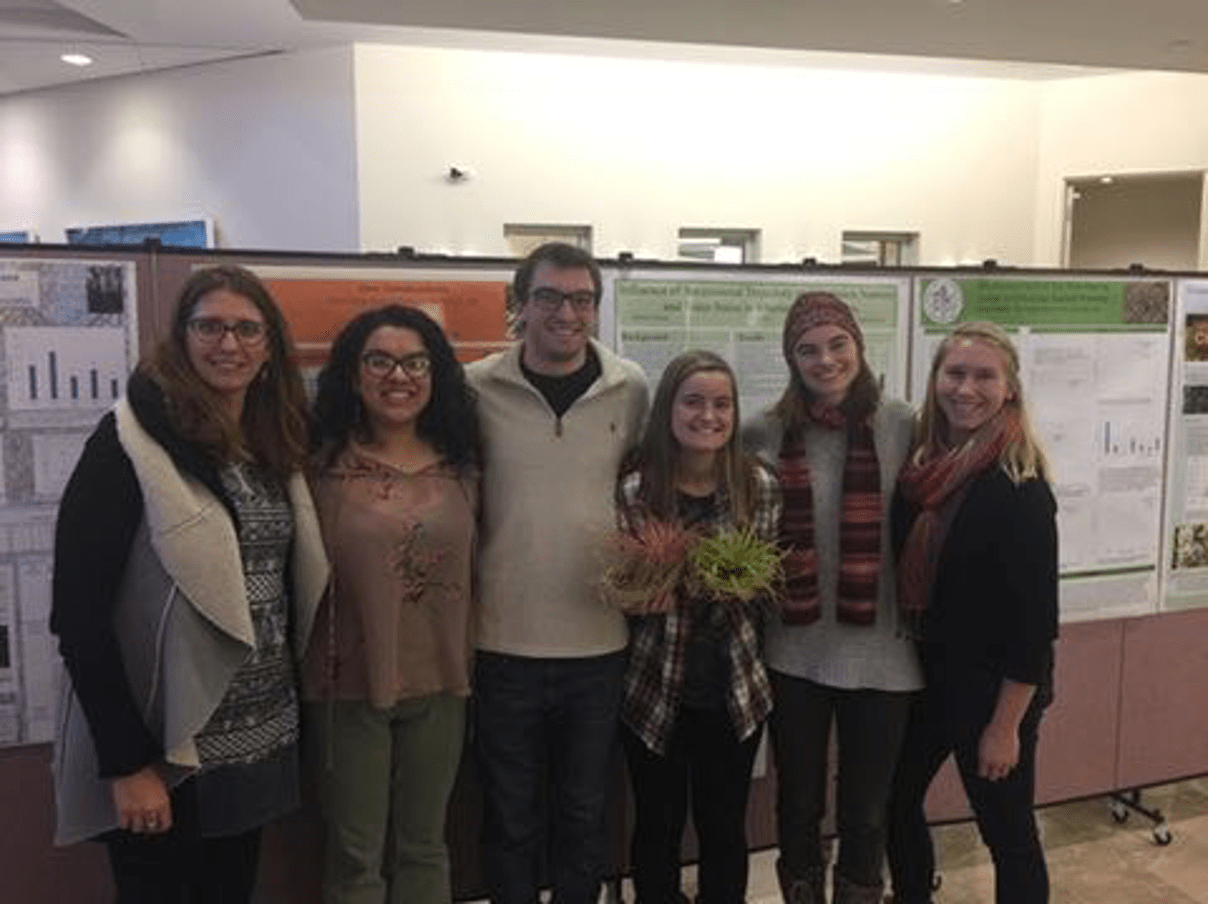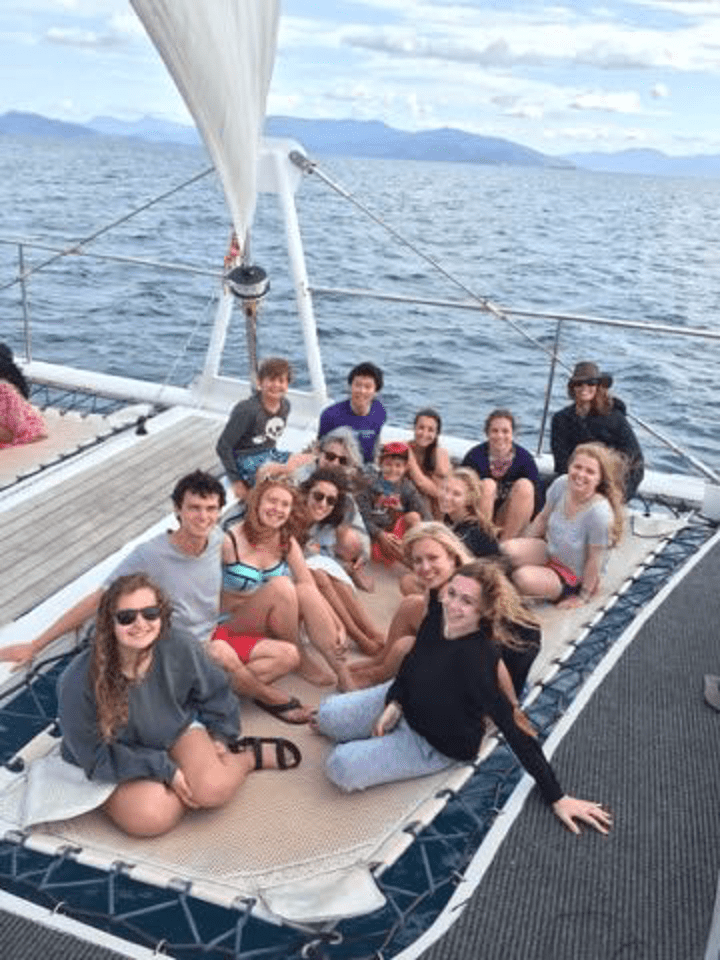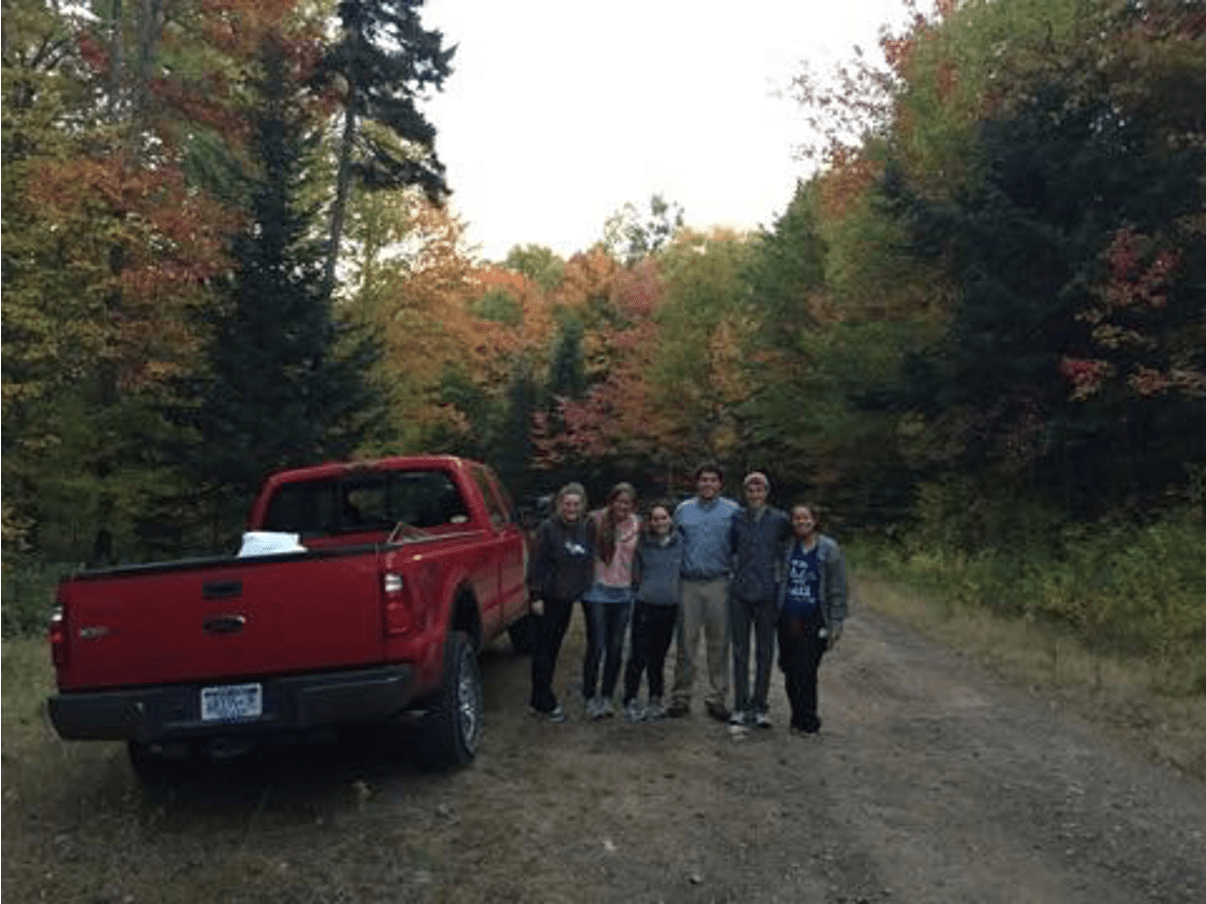
Catherine Cardelús
I am interested in one of ecology's fundamental questions: What are the patterns of biodiversity? As well as in one of today's most pressing questions: How will biodiversity respond to a changing environment? Most of my work has focused specifically on tropical forest canopies where I use multiple ecological approaches to better understand the factors that control species richness and distribution.
In the Cardelús lab we study human impacts on forests - pollution, deforestation, acid rain, deer overabundance. We study locally, regionally, and internationally. We have 4 long-term projects: 1. the conservation of sacred church forests in northern Ethiopia and conservation of sacred forest in northern Madagascar; 2. the impacts and management of overabundant white-tailed deer in Hamilton, NY; 3. the impact of mitigative liming on ecosystem processes in Adirondack State Park, NY; and 4. the effects of predicted increases in nutrient deposition on epiphyte community structure and ecosystem function in the tropical rainforest canopy, Costa Rica. While disparate in location and ecosystem-type, these studies share a scientific framework examining the impacts of human disturbance on community and ecosystem processes. Our work in Ethiopia and in Hamilton, NY, also examines the human-impacts of disturbance and the feedbacks between human communities and forests.
BA, Barnard College, 1996; PhD, University of Connecticut, 2002
Dissertation: Distribution and abundance of vascular epiphytes in tropical wet forests: a multiscale approach. Adviser: Dr. Robin L. Chazdon
Specialties: Plant community and ecosystem ecology; field ecology in both temperate and tropical regions
Biology
Climate Change: Science, Impacts, and Hope, BIOL101
Biodiversity, Evolution and Ecology and Lab, BIOL181, offered each semester
Ecology and Lab, BIOL203
Tropical Ecology with Extended Study to Costa Rica BIOL332
Ecosystem Ecology and Lab, BIOL329
Conservation Biology, BIOL330
Research Tutorial, Investigations in Biodiversity, Community and Ecosystem Ecology, BIOL476
Environmental Studies
Biodiversity and Biogeography of Australia, taught at the University of Wollongong, Australia, ENST309
Community-based Environmental Issues, ENST390
Conservation Biology and Practice, ENST389
CORE
Global Change and You, CoreSP 128/FSEM124
The Science and Practice of Yoga, CoreSP
*denotes student
In Prep.
Baez*, M., M. James*, K. Hankowsky*, I. Helfant, P. Scull, C.L. Cardelús. (in prep.). Development, Implementation and Maintenance of a Deer Management Program in Hamilton, New York.
Woods, C.L., C.L. Cardelús, E. Messing*, M.C. Baez*, P. Ryan*, L. McCulloch*. (in prep). The influence of different epiphyte taxa on the nutrient status of canopy humus: A fertilization experiment.
Published
2025
Maas, B., Cardelus, C., Carrasco‐Rueda, F., Chirango, Y., Gowda, V., Montaño‐Centellas, F., Ostertag, R., Roopsind, A., Vargas, G., Yadok, B.G. and Santiago, L., 2025. Supporting inclusive scientific communities: Insights from the ATBC society survey. Biotropica, 57(1), p.e13378.
2024
Koenig, J., Álvarez-Correa, C. M., Juliana, C., Catherine, L., & Watkins, J. E. (2024). Gametophytes of the Potato Fern, Microgramma brunei. American Fern Journal, 114(4), 249-262.
2022
Casandra Reyes-García, Narcy Anai Pereira-Zaldívar, Celene Espadas-Manrique, Manuela Tamayo-Chim, Nahlleli Chilpa-Galván, Manuel Jesús Cach-Pérez, Marypaz Ramírez-Medina, Ana Maria Benavides, Peter Hietz, Gerhard Zotz, José Luis Andrade, Catherine L. Cardelús, Rodolfo de Paula Oliveira, Helena J. R. Einzmann, Valeria Guzmán Jacob, Thorsten Krömer, Juan P. Pinzón, Juliano Sarmento Cabral, Wolfgang Wanek and Carrie Woods. (2022). New proposal of epiphytic Bromeliaceae functional groups to include nebulophytes and shallow tanks. Plants: 11, 3151. https://doi.org/10.3390/plants11223151
Baez Schon, M., Woods, C.L., Cardelús, C.L. (2022). Sacred Church Forests in Northern Ethiopia: Biodiversity and Cultural Islands. In: Montagnini, F. (eds) Biodiversity Islands: Strategies for Conservation in Human-Dominated Environments. Topics in Biodiversity and Conservation, vol 20. Springer, Cham. https://doi.org/10.1007/978-3-030-92234-4_21
Hietz, P., K. Wagner, F. Nunes Ramos, J. Sarmento Cabral, C. Agudelo, A.M. Benavides, M. J. Cach Pérez, C.L. Cardelús, N.Chilpa Galván, L. Erickson Nascimento da Costa, R de Paula Oliveira, H. J. R. Einzmann, R. de Paiva Farias, V. Guzmán Jacob, J. Kattge, M. Kessler, C. Kirby, H. Kreft, T. Krömer, J. Males, S. Monsalve Correa, M. Moreno-Chacón, G. Petter, C. Reyes-García, A. Saldaña, D. Schellenberger Costa, A. Taylor, N. Velázquez Rosas, W. Wanek, C.L. Woods, G. Zotz. (accepted). Putting epiphytes on the traits map. Journal of Ecology. DOI PDF
2021
McCulloch, L.*; H. Kropp, A. Kholodov, C.L. Cardelús, S.M. Natali, M. Loranty. (2020) Variation in fine root characteristics and nutrient dynamics across Alaskan ecosystems. Ecosystems, 1-16. DOI PDF
2020
Woods, C.L., A. Bitew Mekonnen, M. Baez-Schon*, B. Tsegay Abraha, C.L. Cardelús. (2020). Tree community composition and dispersal syndrome vary with human disturbance in sacred church forests in Ethiopia. Forests 11,10: 1082. DOI PDF
Cardelús, C.L., Bitew*, K. Jensen*, A.M., C.L. Woods, M.C. Baez*, M. Montufar*, K. Bazany*, B.A. Tsegay, P.R. Scull, W. Peck. (2020). Edge effects and human disturbance influence soil physical and chemical properties in Sacred Church Forests in Ethiopia. Plant and Soil. DOI
2019
Cardelús, C.L., C.L. Woods, A. Bitew Mekonnen*, S. Dexter*, P. Scull, B. Tsegay Abraha. (2019). Disturbance impacts the integrity of sacred church forests, Ethiopia. PlosONE. 14, 3: e0212430. DOI News Article
2018
Woods, C. L., S. J. DeWalt, C. L. Cardelús, K. E. Harms, J. B. Yavitt, and S. J. Wright. (2018). Fertilization influences the nutrient acquisition strategy of a hemiepiphytic aroid in a lowland tropical forest understory. Plant and Soil. DOI
Tsegay, Berhanu Abraha, A.T. Tsadik Weldeyes, C.L. Cardelús. Traditional use of botanicals in reducing post harvest loss at crop stacking stage in Ethiopia: A case of Farta district. Indian Journal of Traditional Knowledge. 17, 3: 534-541. PDF
2017
Cardelús, C.L., P. Scull, A. Wassie, C.L. Woods, P. Klepeis, E. Kent, & I. Orlowska. (2017). Shadow conservation and the persistence of sacred forests in northern Ethiopia. Biotropica. 49, 5: 725-733. DOI
Woods, C.L., C.L. Cardelús, P. Scull, A. Wassie, M. Baez*, P. Klepeis. (2017). Stone walls and sacred forest conservation in Ethiopia. Biological Conservation. 26 209-221. DOI
Scull, P. C.L. Cardelús, P. Klepeis, C.L. Woods, A. Frankl, J. Nyssen. (2017). The resilience of Ethiopian church forests evidenced from a diachronic analysis using 1930’s aerial photographs. Land Degradation and Development. 28: 450-458. PDF DOI
2016
Klepeis, P., I. Orlowska, E. Kent, C.L. Cardelús, P. Scull, A. Wassie & C.L. Woods. (2016). Ethiopia church forests: a hybrid model of protection. Human Ecology. 44: 715-730. PDF DOI
2015
Woods, C.L., S.J. Dewalt, & C.L. Cardelús. (2015). Microhabitat associations of vascular epiphytes in a wet tropical forest canopy. Journal of Ecology. 103: 421-430. DOI
2014
Oberbillig, D., Randle, D.C., Middendorf, G., & C.L. Cardelús. (2014) Outdoor Learning in Formal Ecological Education – Looking to the Future. Frontiers in Ecology and the Environment 27: 419-420. DOI
2013
Cardelús, C.L., & G. Middendorf. (2013) Ecological literacy: the educational foundation for informed public decision making. Frontiers in Ecology & the Environment 11: 330-331. DOI
Cardelús, C.L., M. Baimas-George*, M.D. Lowman, & A. Wassie Eshete. (2013). Carbon Sequestration in Ethiopia. Edited volume: Treetops at Risk: Challenges of Global Canopy Ecology and Conservation. DOI
McCay, T.S., C.L. Cardelús, & M. Neatrour. (2013). Rate of litter decay and litter macroinvertebrates in limed and unlimed forests of the Adirondack Mountains, USA. Forest Ecology and Management 304:254-260. DOI
Cardelús, C.L., P. Scull, J. Hair*, M. Baimas-George*, M.D. Lowman, & A. Wassie Eshete. (2013). A preliminary assessment of Ethiopian sacred groves at the landscape and ecosystem scales. Diversity 5 (2): 320-334. DOI
2012
Watkins, J.E. Jr. & C.L. Cardelús. (2012). Ferns in an angiosperm world: cretaceous radiation into the epiphytic niche and diversification on the forest floor. International Journal of Plant Sciences. 173, 6: 695-710. DOI
Beck, C., K. Klemow, J. Paulson, A. Bernstein, M. Lam, G. Middendorf, J. Reynolds, K. Belanger, C. Cardelús, C.Cid. (2012). Add Ecology to the Pre-Medical Curriculum. Science 335: 1301. DOI
Cardelús, C.L., M. Lowman, & A. Wassie Eshete. (2012). Uniting Church and Science for Conservation. Science. 335: 916-917. PDF DOI
Cardelús, C.L. (2012). Surveying Epiphytes in Forest Canopies. In Methods in Forest Canopy Research. Eds. M.D. Lowman & T. Schowalter. University of California Press.
2011
Laurance, W.F., D.C. Useche, L.P. Shoo, S.K. Herzog, M. Kessler, F. Escobar, G. Brehm, J.C. Axmacher, I. C. Chen, L.A. Gámez, P. Hietz, K. Fiedler, T. Pyrcz, J. Wolf, C.L. Merkord, C.L. Cardelús, A.R. Marshall, C. Ah-Ping, G.H. APlet, M. del Coro Armizmendi, W. J. Baker, J. Barone, C.A. Bruhl, R.W. Bussmann, D. Cicuzza, G. Eilu, M.E. Favila, A. Hemp, C. Hemp, J. Homeier, R.B. Huey, J. Hurtado, J. Jankowski, G. Kattán, J. Kluge, T. Kromer, D. Lees, M. Lehnert, J.T. Longino, J. Lovett, P.H. Martin B.D. Patterson, R.G. Pearson, K.S. H. Peh, B. Richardson, M. Richardson, M. Samway, F. Senbeta, T.B. Smith, T. Utteridge, J.E. Watkins, Jr., R. Wilson, S.E. Williams, & C. Thomas. (2011). Global warming and the vulnerability of tropical biota. Biological Conservation. 144: 548-557. PDF DOI
2010
Cardelús, C.L. & M.C. Mack. (2010). The nutrient status of epiphytic ferns, orchids and bromeliads and their host tree along an elevation gradient, Costa Rica. Plant Ecology 207 (1): 25-37. PDF DOI
Cardelús, C.L. (2010). Litter decomposition in the canopy and on the forest floor of three tree species in a tropical rainforest, Costa Rica. Biotropica 42 (3): 300-308. PDF DOI
2009
Cardelús, C.L. & J.E. Watkins, Jr. (2009). Habitat differentiation of ferns in a lowland tropical rainforest. American Fern Journal 99 (3): 162-175. PDF DOI
Cardelús, C.L., M.C. Mack, C.L. Woods, J. DeMarco & K. Treseder. (2009). Nutrient cycling in canopy and forest floor soils in a lowland tropical wet forest, Costa Rica. Plant and Soil 318 (1): 47-61. PDF DOI
2008
Colwell, R.K., G. Brehm, C.L. Cardelús, A.C. Gilman & J.T. Longino (2008). Global warming, elevational range shifts, and lowland biotic attrition in the wet tropics. Science 258-261. PDF DOI http://viceroy.eeb.uconn.edu/ColwellEtAlScience.htm
Watkins, Jr., J.E., C.L. Cardelús & M.C. Mack (2008). Ants mediate nitrogen relations of an epiphytic fern. New Phytologist 180 (1): 5-8. PDF DOI
2007
Robertson, J.M., C.L. Cardelús, and M.I. Williams (2007). Arboreal oviposition site in the fossorial snake, Enulius sclateri. Herpetological Review. 38(4): 466-467. PDF
Watkins, Jr. J.E., P. Rundel, & C.L. Cardelús. (2007) The influence of plant life form on carbon and nitrogen relationships in tropical rainforest ferns. Oecologia 153 (2): 225-232. PDF DOI
Cardelús, C.L. (2007). Vascular epiphyte communities in the inner-crown of Hyeronima alchorneoides and Lecythis ampla at La Selva Biological Station, Costa Rica. Biotropica 39 (2): 171-176. Full text DOI
2006
Watkins Jr., C.L. Cardelús, R.C. Colwell, & R. Moran. (2006). Species richness and distribution of ferns along an elevational gradient in Costa Rica. American Journal of Botany 93 (1) 73-83. PDF DOI
Cardelús, C.L., R.C. Colwell, J.E. Watkins, Jr. (2006). Vascular epiphyte distribution patterns: explaining the mid-elevation richness peak. Journal of Ecology 94 (1): 144-146. PDF DOI
2005
Cardelús, C.L. & R.L. Chazdon. (2005) Inner-crown microenvironments of two emergent Tree species in a lowland wet forest. Biotropica 37: 238-244. PDF DOI
Grants
- 2023-2023 Colgate Major Research Grant. Co-PI with James E. Watkins, Jr. Exploratory Research in the Colombian Rainforest Canopy, $7681.
2022-2023 Colgate Major Research Grant. Exploratory Research in the Colombian Rainforest Canopy, $3534. - 2019-2021 The Upstate Institute, Colgate University: Team-Taught Course Development Grant for Conservation Biology: Science & Practice. The intent of this team-teaching RFP is to seek novel, innovative team-teaching proposals that benefit both the faculty and students involved in the team-taught course.
- 2017-2019 The Upstate Institute & Sustainability Council, Colgate University: The Impact of White-Tailed Deer on Colgate Forests: Richness. PI Cardelús; Co-PI’s: Fuller, McCay, Scull, Watkins, $18,000.
2015-2018 NSF RUI-CNH Small Grant: Shadow Conservation: What are the Mechanisms of Religious Management for Forest Persistence. PI Cardelús; Co-PI’s: P. Scull, P. Klepeis, E. Kent, A. Wassie Eshete, I. Orlowska, C. Woods. $500,000
2014-2019 MRI: Acquisition of a TXRF spectrometer for Research in Chemistry, Biology, and Geology. PI Rowlett; Co-PI’s: C. Cardelús, R. Fuller, R. April. $102,740
2014-2015 PI on Collaborative Research Proposal: Colgate Picker Interdisciplinary Science Institute: What socio-ecological processes create strong stewardship of church forests of northern Ethiopia. $100,000. Co-PI’s: P. Scull, P. Klepeis, E. Kent, A. Wassie Eshete, I. Orlowska, C. Woods.
2014-2015 Sponsored Research Support Fund. Colgate Research Council, $15,133
2014-2015 Research Council Major Grant, Colgate University: Experimental study of nutrient addition and water exclusion on canopy ecosystem processes and epiphyte community structure. $7,825
2013-2014 PI on Collaborative Research Proposal: Colgate Picker Interdisciplinary Science Institute: Does religious management supersede the socio-ecological drivers of forest change in sacred groves of northern Ethiopia? $90,000. Co-PI’s: P. Scull, P. Klepeis, E. Kent, A. Wassie Eshete, M. Lowman.
2013-2014 Research Council Major Grant, Colgate University: Experimental Study of Nutrient Addition and Water Exclusion on Canopy Processes and Epiphyte Community Structure. $7500
2012-13 The Upstate Institute, Colgate University: Above and Belowground Responses to Acid Rain Mitigation in Adirondack State Park. $5000
2010-13 NSF: Research Initiation Grant: Experimental Study of Canopy Nutrient Limitation on Ecosystem Processes and Community Structure. $187,629
2010 Picker Interdisciplinary Science Institute Grant: Conservation of Ethiopian Church Forests. $5,307.00 (http://www.catherinecardelus.com/ethiopia/)
2008-09 NSF Research Starter Grant: Exploring the nutrient dynamics of
herbaceous taxa from temperate and tropical regions, $50,000
2000-2001 NSF Doctoral Dissertation Improvement Grant, $5000
2000 Organization for Tropical Studies Research Grant, $3000
1998 Organization for Tropical Studies, Post-course Grant, $600
Fellowships
- 2006-2008 Postdoctoral Research Fellowship, South East Alliance for Graduate
Education and the Professoriate (SEAGEP-NSF), $50,000
2003-2006 Minority Postdoctoral Research Fellowship, NSF, $160,000
2003, 2007 Postdoctoral Research Fellowship, Mellon Foundation, $48,000
2002 Dissertation Research Fellowship, University of Connecticut, $3,000
2001 Multicultural Fellowship, University of Connecticut, $7,500
1998 Multicultural Summer Fellowship, University of Connecticut, $3000
1998-2001 NSF Graduate Student Research Fellowship, $55,000
1998 NSF Minority Graduate Student Research Fellowship (Awarded)
1997-1998 Multicultural Fellowship, University of Connecticut, $15,000
1996 The Grace Potter Rice Fellowship, Columbia University, $4,000
1996 Summer Fellowship, Barnard College, $500
Awards & Honors
- 2010, 2013 Extended Study Funded for three-week trip to Costa Rica Associated with my (Funded 2019) course: Tropical Ecology, BIOL 332. ~$22,000
(http://www.catherinecardelus.com/extended-study-2010/; http://www.catherinecardelus.com/blog/)
2007 Travel Award, Ecological Society of America (ESA) and Women
Evolving Biological Sciences (WEBS), $700
2002 Bamford Award, University of Connecticut, $500
2002 Travel Award, University of Connecticut, $1,200
2000 Biodiversity Award, University of Connecticut, $500
1999 Edgar T. Wherry Award, American Fern Society & BSA, $500
1999 Pilot Study Award, Organization for Tropical Studies, $1500
1998 Bamford Award: Summer, University of Connecticut, $500
1996 Hermann Botanical Prize, Barnard College, $500
1996 Cum Laude, Barnard College
1994-1996 Dean’s List, Barnard College
Professional Service
- 2020-2023: Elected Council Member, Association for Tropical Biology and Conservation; Co-chair Capacity Building Committee; Member, Diversity Equity and Inclusion Committee
- June 2018: Network for Conservation Educators and Practitioners (NCEP): Conservation Teaching and Learning Studio, Participant (American Museum of Natural History)
- 2013-present: Certified Senior Ecologist, Ecological Society of America.
- 2013-present: The Cardelús lab is a USDA APHIS Inspected Facility Authorized to Receive Soil
- May 2015: InterGroup Dialogue Facilitator Training, Colgate University
- Jan 2013: Managing Editor, Springer Science Reviews Journal.
- Sept. 2013: Launch of Ecoliteracy series in Frontiers in Ecology and the Environment. Co-Edited with Dr. George Middendorf and co-editors were responsible for proposal, solicitation, and editing of series. Papers published monthly through July 2014.
- June 2013: Co-organized symposium with Carrie Woods (Clemson University) at the annual Association for Tropical Biology Meeting in San Jose, Costa Rica titled: Changing water and nutrient regimes in the rainforest canopy: the impact on the resident epiphytes.
- April 2012: Panelist: Energy, Community and Colgate. Colgate University
- Fall 2011: Review Panelist: NSF DEB
- 2007-2011: Member, Education and Human Resources Committee for the Ecological Society of America.
- Aug. 2010: Co-organized a special session titled: Using Best Science to Educate a Public Confused about Global Climate Change. Ecological Society of America, Annual Meeting. Pittsburgh, PA.
- May 2009: Interviewed for Nature Magazine by Karen Kaplan for ‘Unmasking the Imposter.’ Nature 459, 468-469.
- April 2009: Interviewed for Science Magazine by Elisabeth Pain for ‘Professional Service.’
- Feb. 2009: Workshop Speaker: Career Boosters for Women and Minority Scientists. Association for the Advancement of Sciences Annual Meeting, Chicago.
- June 2008: Interviewed for Science Careers by Elisabeth Pain: A Self-Made Climber.
- June 2008: Association for Tropical Biology & Conservation Symposium Co-chair with G. Zotz: Diversity in the Canopy.
- Oct. 2007: NSF ADVANCE Workshop, Women Evolving Biological Sciences (WEBS). Selected participant. 2007, Pack Forest Conference Center, WA.
- Oct. 2007: Ecophylogentics Workshop Participant, Harvard Forest, MA.
- 2007: ESA Judge for student poster and oral presentations
- 2005: Ecoinformatics Workshop Participant, The Science Environment for Ecological Knowledge (SEEK), University of New Mexico, NM.
- 2005-present Ad-Hoc Reviewer: American Fern Journal, American Journal of Botany, Association for Women in Science, Austral Ecology, Biotropica, Conservation Biology, Ecological Society of America, Annual Meeting Symposia and Oral Presentations, Ecology, Folia Geobotanica, Forest Ecology and Management, Global Change Biology, Global Ecology and Biogeography, Journal of Biogeography, Journal of Ecology, Journal of Tropical Ecology, Murdoch Charitable Trust, National Science Foundation, Nature Scientific Reports, Plant Ecology, Selbyana, Soil Biology and Biochemistry; Tenure Review.
2020: Soil nutrient dynamics in Ethiopian Sacred Forests, Plant and Soil
2019: BBC: The Sacred Forests of Ethiopia by Sarah Hewitt
2019: The Last of Ethiopia's Vanishing Forest are Clinging to Sacred Churches
2016: Discover Magazine Article: Revelations in the Rainforest Canopy by Sarah Hewitt
2016: Fieldwork: Extreme Research by Emily Sohn, Nature (529)
2015: Colgate Scene: A Lab in the Canopy by Sarah Hewitt
2010 Professor Hunts Answers in Trees
2009: Leveling the Playing Field by Karen Kaplan, Nature (458)
Cardelús Lab

Fall 2017: Carol Rodriguez, Keith Hankowsky, Alison Hogue, Sabrina Farmer, Sonya Dexter

Fall 2016: Grace Thomas, Michael James, Bryan Acevedo, Erin DiGulglielo, Donnor Dix, Martha Montufar

Fall 2015: Study Group in Australia!

Fall 2014: Elizabeth Leighton, Danielle Mazzeo, Shannon Pierce, Thomas Wobby, Joseph Coplan, Mabel Baez
Protocols
Sample Collection and Preparation
Soils
Plants
Grinding Plant Material on Wiley Mill
Total Phosphorus in Plants and Soil
Malachite Green Method for Phosphorus
Sample Analysis
Running Clarity Elemental Analysis Software



